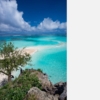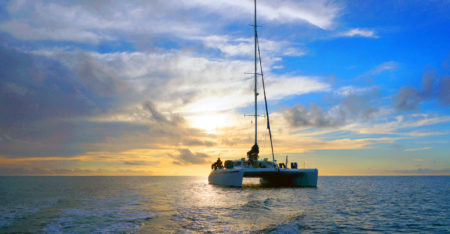Thoughts from an Encounter with a Baby Humpback
I was on my first snorkel, on the lookout for humpback whales near Tonga, when a monstrous creature slowly rose through the murky water from the depths of the ocean. She was close enough that I could see her eye studying me. I was afraid and, while holding her gaze, backed away as fast as I could.

As close as it gets. Photo: Jeff Foott
My friend and wildlife photographer, Jeff Foott, had invited myself and my husband, Jay Smith, to come along with Judith Zimmerman, Ted Wood and Amanda Prentiss, to spend seven days with Whale Discoveries Ltd. We were guests of an Australian couple, Dave and Tris, and their two teenagers, Dior and Kai, on a 49-foot catamaran. I felt like I was being invited to live in a fantasy family where the distractions of modern life were cast away but the conveniences could be tapped into when desired. School was done online and the family worked together as a team to create a friendly eco-tourism business.
Humpback whales, known for the way they arch their backs high out of the water before diving, traditionally breed near Tonga and then the males return to Antarctica to feed, followed by the mothers and newborn calves, as soon as they are large enough to make the journey. Besides being taken aback by how large these prehistoric looking remnants are—an adult is about 45 feet long and weighs approximately 6,600 pounds—I was surprised at how interactive and playful the calves are. On a typical snorkeling escapade, the mom might come up to make sure the new playmates (us) were safe, and then drift back to the ocean floor to have a snooze. The calf would then venture up and entertain us by rolling over and over with its pectoral fins, breaching, diving down and rolling over, as if it was in a performance. Except that we were not merely spectators. At times, the calf would come close to us and hesitate, as if asking us to join in the fun. Every fifteen minutes or so, it would dive back down under mom to “check in” and then come back up to play.

Momma and calf. Photo: Jeff Foott
Life has not always been so carefree for these majestic animals. In the past, they were aggressively hunted for oil, processed from the blubber, which was used to light the streets of growing cities around the world. If the International Whaling Commission had not stepped in and put a moratorium on all commercial whaling, these whales would now be extinct. However, they are now threatened by modern day problems such as acidification of the oceans and climate change.
On the surface though, all seemed sublime. Often we would land on uninhabited islands and were free to explore. On our last day, I earnestly scoured the white sand in hopes of finding a unique shell as a souvenir, something that evoked the same awe I was experiencing on this trip, and would help transport my mind back to a peaceful place. I was soon rewarded with the most colorful shell I have ever seen. To my distress, it was still inhabited by a living hermit crab. I asked a visiting captain what to do and she said, “The crab lives in that shell. It will die without its home.”

Another one of Tonga’s many islands. Photo: Judith Zimmerman
Those words haunted me for days after I returned to Utah. It was, after all, just a hermit crab. But then it occurred to me that I was making a judgment call based on the size of the animal. How easy it would have been to kill the hermit crab for the short-term gain of taking the shell—its home. It reminded me of a friend who was permanently driven from his house by the fumes from a gas pipeline that appeared on his property without warning.
Our actions, no matter how small, are powerful. They not only reflect our innermost convictions, they are ripples that can grow into a wave of change. On November 8th, let’s take our convictions to the polls and turn them into action.

